The Spectral Cell Analyzers Market is estimated to be valued at USD 1.7 billion in 2025 and is projected to reach USD 3.3 billion by 2035, registering a compound annual growth rate (CAGR) of 6.8% over the forecast period.
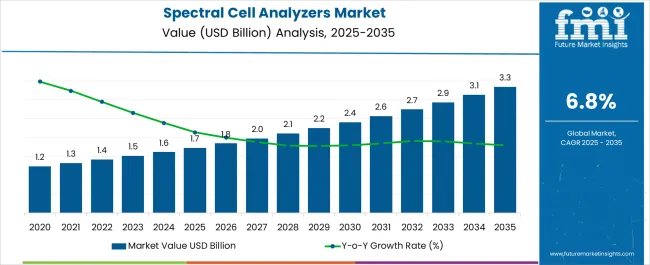
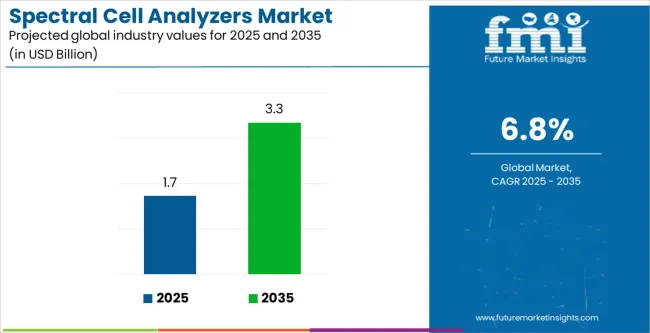
| Metric | Value |
|---|---|
| Spectral Cell Analyzers Market Estimated Value in (2025 E) | USD 1.7 billion |
| Spectral Cell Analyzers Market Forecast Value in (2035 F) | USD 3.3 billion |
| Forecast CAGR (2025 to 2035) | 6.8% |
The spectral cell analyzers market is advancing rapidly, driven by increasing adoption of high resolution cell analysis technologies in biomedical research, clinical diagnostics, and translational studies. Rising demand for precise cellular profiling, coupled with the need for advanced diagnostic tools in oncology, immunology, and infectious disease management, is fostering significant uptake.
Technological progress in multi parametric analysis, automation, and data integration has improved throughput and accuracy, supporting broader clinical and research applications. Investments by healthcare institutions and academic research centers are further reinforcing market expansion, while industry collaborations are enabling innovations in compact, user friendly systems.
The outlook remains promising as spectral analysis continues to play a pivotal role in precision medicine, biomarker discovery, and advanced therapeutic development.
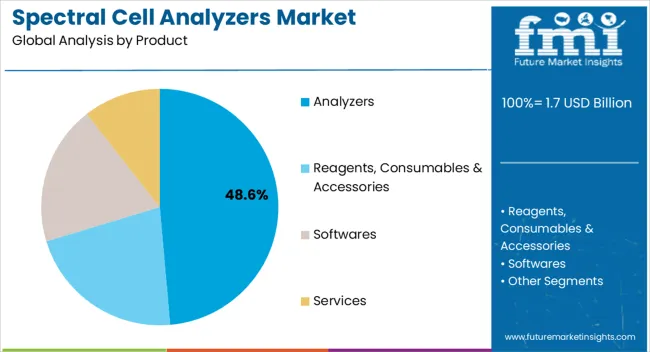
The analyzers segment is projected to hold 48.60% of total market revenue by 2025 within the product category, positioning it as the leading segment. This growth is being propelled by rising demand for advanced instruments that provide high sensitivity, multi color detection, and robust data accuracy.
Their ability to process complex cell populations efficiently has supported their adoption in both research and clinical applications. Continuous innovation in analyzer design, including user friendly interfaces and automation, has improved laboratory workflows and reduced analysis time.
These advantages have reinforced the dominance of analyzers within the product category, making them indispensable for high precision cell analysis.
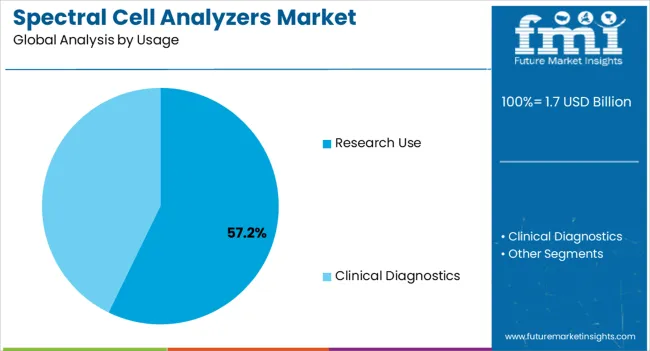
The research use segment is expected to represent 57.20% of market revenue by 2025 within the usage category, making it the most prominent segment. Growth in this segment is being driven by increasing investment in life sciences research, particularly in immunology, oncology, and stem cell studies.
The versatility of spectral analyzers in handling complex assays and large datasets has made them essential tools in academic, pharmaceutical, and biotechnology research. Their role in advancing biomarker discovery, drug development, and personalized medicine is central to their growing adoption.
The emphasis on innovation and the expanding scope of translational research have further reinforced the leadership of research use within this market.
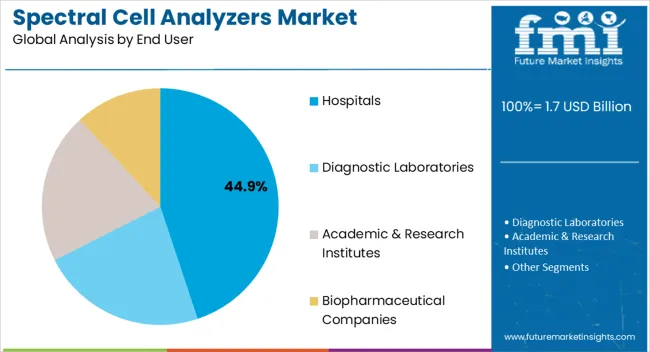
The hospitals segment is set to capture 44.90% of total revenue by 2025 under the end user category, establishing itself as a key growth driver. This dominance is attributed to the growing demand for advanced diagnostic solutions in oncology, hematology, and infectious disease management.
Hospitals are increasingly adopting spectral cell analyzers for their accuracy, speed, and ability to provide multi parametric insights in clinical diagnostics. Integration of these systems into hospital laboratories has supported better patient outcomes by enabling precise and timely diagnoses.
The expansion of hospital infrastructure and investments in advanced diagnostic technologies have further accelerated the adoption of spectral analyzers, solidifying their position as a critical tool in modern healthcare settings.
From 2020 to 2025, the global spectral cell analyzers market experienced a CAGR of 6.3.3%, reaching a market size of USD 1.7 billion in 2025.3.
From 2020 to 2025, the global spectral cell analyzers market industry witnessed steady growth. Over the years, the market for spectral cell analyzers has grown steadily. Flow cytometry, particularly spectral cell analysis, has become widely used in a variety of academic and therapeutic settings. In the past, technological advancements, growing applications in disciplines such as immunology, cancer research, and drug development, and rising demand for personalized medicine were driving drivers for market expansion.
Future Forecast for Spectral Cell Analyzers Market Industry:
Looking ahead, the global spectral cell analyzers market industry is expected to rise at a CAGR of 7.2% from 2025.3 to 203.33.3. During the forecast period, the market size is expected to reach USD 3.3.0 billion by 203.33.3.
The spectral cell analyzers market industry is expected to continue its growth trajectory from 2025.3 to 203.33.3. The emphasis on personalized medicine is projected to grow in the coming years. With its capacity to perform extensive cellular analysis, spectral cell analyzers will play a critical role in providing precise diagnosis, prognosis, and therapy selection. Demand for spectral cell analyzers will rise as personalized medicine becomes more popular.
Single-cell analysis methods are gaining popularity in both scientific and therapeutic settings. Because spectral cell analyzers can do high-resolution and multi parametric analysis, they are ideal for single-cell analysis. As the need for single-cell analysis grows, spectral cell analyzers will play an important role in driving market expansion.

| Country | The United States |
|---|---|
| Market Size (USD Million) by End of Forecast Period (2035) | USD 3.3 million |
| CAGR % 2025 to End of Forecast (2035) | 8.9% |
The spectral cell analyzers market industry in the United States is expected to reach a market size of USD 3.3 million by 2035, expanding at a CAGR of 8.9%. The biopharmaceutical business in the United States is well-established and prospering, with major investments in research and development. The market is predicted to rise due to increased demand for spectral cell analyzers in drug discovery, biologics manufacturing, and quality control applications.
| Country | The United Kingdom |
|---|---|
| Market Size (USD Million) by End of Forecast Period (2035) | USD 149.4 million |
| CAGR % 2025 to End of Forecast (2035) | 8.7% |
The spectral cell analyzers market industry in the United Kingdom is expected to reach a market size of USD 149.4 million, expanding at a CAGR of 8.7% during the forecast period due to growing biotechnology center. The United Kingdom offers world-class research and academic institutions, which help to drive demand for spectral cell analyzers. These organisations promote research operations in a variety of domains, including immunology, cancer research, and drug discovery, which leads to the use of spectral cell analyzers.
| Country | China |
|---|---|
| Market Size (USD Million) by End of Forecast Period (2035) | USD 1.7 million |
| CAGR % 2025 to End of Forecast (2035) | 9.1% |
The spectral cell analyzers market industry in China is anticipated to reach a market size of USD 1.7 million, moving at a CAGR of 9.1% during the forecast period. The spectral cell analyzers market industry in China is expected to grow prominently due to the increasing government support and investments. The Chinese government has aggressively promoted the growth of the life sciences industry. Initiatives like Made in China 2025 and increasing research and development spending provide chances for spectral cell analyzer producers and promote market expansion.
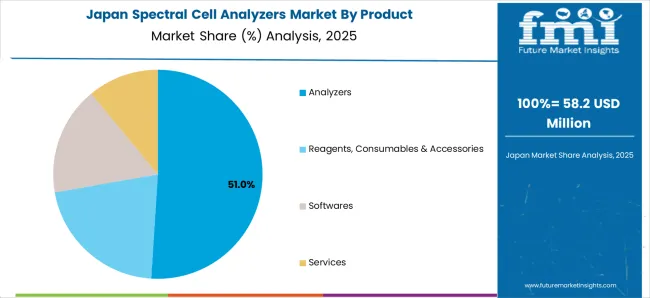
| Country | Japan |
|---|---|
| Market Size (USD Million) by End of Forecast Period (2035) | USD 223.5 million |
| CAGR % 2025 to End of Forecast (2035) | 8.4% |
The spectral cell analyzers market industry in Japan is estimated to reach a market size of USD 223.5 million by 2035, thriving at a CAGR of 8.48%. The market in Japan is predicted to grow because of its strong research and academic institutions. Japan boasts world-class research and educational facilities, which contribute to the high demand for spectral cell analyzers. These organisations promote research operations in a variety of domains, including immunology, cancer research, and drug discovery, which leads to the use of spectral cell analyzers.
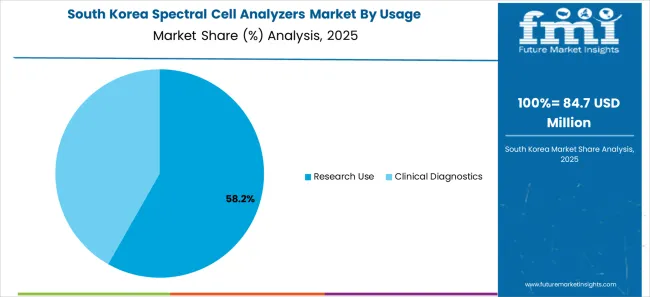
| Country | South Korea |
|---|---|
| Market Size (USD Million) by End of Forecast Period (2035) | USD 67.9 million |
| CAGR % 2025 to End of Forecast (2035) | 6.6% |
The spectral cell analyzers market industry in South Korea is expected to reach a market size of USD 67.9 million, expanding at a CAGR of 6.6% during the forecast period. South Korea is well-known for its emphasis on innovation and research and development financing. Continuous technical improvements in spectral cell analyzers, as well as financing from government agencies, research grants, and private ventures, have the potential to drive market expansion.
The reagents, consumables & accessories dominated the spectral cell analyzers market industry with a market share of 53.5% in 2025. End users anticipate reagents, consumables, and accessories that have been specially created and optimized for use with their spectral cell analyzers. Compatibility provides precise and dependable outcomes, while optimized components improve workflow efficiency and overall system performance.
Customers value reagents, consumables, and accessories that are simple to use and easily integrate into their workflow. User-friendly components, clear instructions, and simpler protocols all contribute to time savings and mistake reduction, boosting overall efficiency and convenience.
The research use is dominating the spectral cell analyzers market with the market share of 79.6% in 2025. The combination of multi-parametric analysis, high sensitivity, thorough cellular analysis, flexibility, technical developments, and the capacity to examine cellular heterogeneity has contributed to spectral cell analyzers' widespread usage in research. Spectral cell analyzers are valuable tools for researchers in a variety of domains for expanding their understanding of cellular biology and unravelling complicated biological processes.
The biopharmaceutical companies dominated the spectral cell analyzers market with the market share of 49.0% in 2025. Due to their unique capabilities and benefits, spectral cell analyzers have seen widespread adoption among biopharmaceutical businesses. Biopharmaceutical firms that use spectral cell analyzers may optimize their manufacturing processes, maintain product quality and consistency, ease research and development, and enhance their understanding of cellular biology and medicinal efficacy. In the biopharmaceutical business, these variables lead to increased efficiency, shortened medication development schedules, and better product safety.
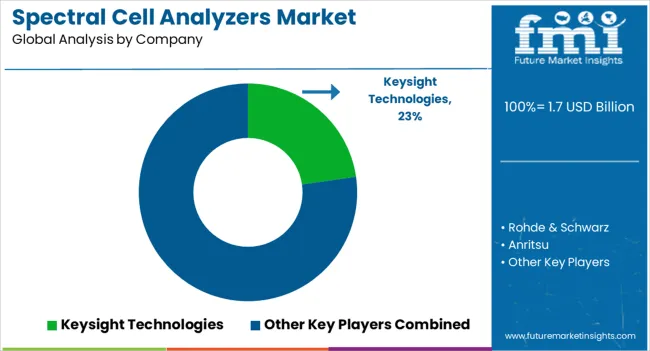
The spectral cell analyzers sector is fiercely competitive, with many companies fighting for market dominance. To stay ahead of the competition in such a circumstance, essential players must employ smart techniques.
Key Strategies Used by the Participants
Key players focus on developing and introducing innovative products to address unmet needs in the market. They invest in research and development to improve existing formulations, delivery systems, and enhance the efficacy and safety of the products.
Key players often form strategic partnerships and collaborations with other companies, research institutes, or healthcare organizations, these partnerships allow for knowledge sharing, joint research and development efforts, and access to complementary technologies or expertise.
Key players strive to expand their presence in different geographic regions to tap into new markets and reach a wider customer base. They may establish subsidiaries, distribution networks. Or strategic alliances in various countries to strengthen their market position.
Companies in the market may engage in mergers or acquisitions to consolidate their product portfolio, acquire new technologies, these strategic moves allow companies to enter new market segments, gain access to novel products or intellectual property, and achieve synergies in terms of research, manufacturing, or distributions.
Key Developments in the Spectral Cell Analyzers Market:
The global spectral cell analyzers market is estimated to be valued at USD 1.7 billion in 2025.
The market size for the spectral cell analyzers market is projected to reach USD 3.3 billion by 2035.
The spectral cell analyzers market is expected to grow at a 6.8% CAGR between 2025 and 2035.
The key product types in spectral cell analyzers market are analyzers, reagents, consumables & accessories, softwares and services.
In terms of usage, research use segment to command 57.2% share in the spectral cell analyzers market in 2025.






Full Research Suite comprises of:
Market outlook & trends analysis
Interviews & case studies
Strategic recommendations
Vendor profiles & capabilities analysis
5-year forecasts
8 regions and 60+ country-level data splits
Market segment data splits
12 months of continuous data updates
DELIVERED AS:
PDF EXCEL ONLINE
Spectral Computed Tomography Market Size and Share Forecast Outlook 2025 to 2035
Spectral Sensor Market Size and Share Forecast Outlook 2025 to 2035
Hyperspectral Imaging Market Forecast and Outlook 2025 to 2035
Hyperspectral Imaging Camera Market Size and Share Forecast Outlook 2025 to 2035
Hyperspectral Imaging for Seal Integrity Market Analysis Size and Share Forecast Outlook 2025 to 2035
Multispectral Camera Market Growth – Trends & Forecast 2024-2034
Medical Hyperspectral Imaging Market - Growth, Demand & Forecast 2024 to 2034
Cellulite Treatment Market Size and Share Forecast Outlook 2025 to 2035
Cellulose Derivative Market Size and Share Forecast Outlook 2025 to 2035
Cellulose Film Packaging Market Size and Share Forecast Outlook 2025 to 2035
Cell Therapy Systems Market Size and Share Forecast Outlook 2025 to 2035
Cellular IoT Market Size and Share Forecast Outlook 2025 to 2035
Cell Isolation Market Size and Share Forecast Outlook 2025 to 2035
Cellulose Ether and Derivatives Market Size and Share Forecast Outlook 2025 to 2035
Cellular Push-to-talk Market Size and Share Forecast Outlook 2025 to 2035
Cell Culture Waste Aspirator Market Size and Share Forecast Outlook 2025 to 2035
Cell Culture Media Market Size and Share Forecast Outlook 2025 to 2035
Cellulosic Polymers Market Size and Share Forecast Outlook 2025 to 2035
Cellbag Bioreactor Chambers Market Size and Share Forecast Outlook 2025 to 2035
Cell Surface Markers Detection Market Size and Share Forecast Outlook 2025 to 2035

Thank you!
You will receive an email from our Business Development Manager. Please be sure to check your SPAM/JUNK folder too.
Chat With
MaRIA